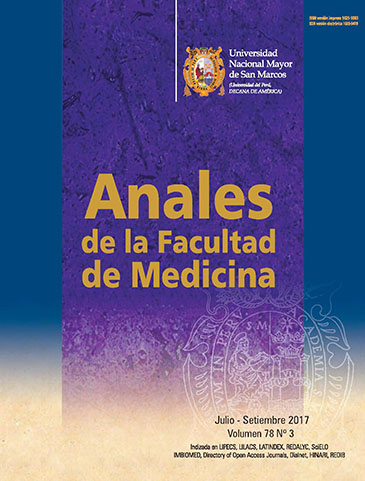Proposal of a correction factor to measurements of hemoglobin by altitudinal tiers in 6-19 month old infants in Peru
DOI:
https://doi.org/10.15381/anales.v78i3.13759Keywords:
Hemoglobin, Altitude, Children, Anemia.Abstract
Introduction: Anemia is the largest nutritional problem in Peru. Objective: To determine changes in hemoglobin level according to altitude in Peruvian children in order to propose a national correction factor. Design: Descriptive, cross-sectional study. Setting: At national level. Participants: 22 500 children aged 6 to 59 months-old. Interventions: Data from the Demography and Family Health Survey (ENDES 2015) was used to select non-anemic children for the proposed formulation. An exponential regression model was used and the correction factor for hemoglobin (according to altitude) was: 8.3 *e (0,000426 * height) -12. Main outcome measure: Prevalence of anemia according to altitude. Results: The prevalence of anemia was compared according to the proposed correction factor versus the traditional formula used by the Center of Disease Control (CDC). The difference at national level reached 2.5%, being greater from 3 000 meters over sea level (9.2%). Regions with a difference over 5 percentage points were Junín (5,6%), Cusco (5,7%), Ayacucho (6%), Pasco (7,4%), Apurímac (7,8%), Huancavelica (9,9%), and Puno (12,7%). Conclusion: The proposed correction factor identifies lower prevalence of anemia compared to the traditional factor. This observation may be due to the differences found above 3 000 meters over the sea level.Downloads
Published
2017-11-30
Issue
Section
Artículo Original
License
Copyright (c) 2017 Marco Bartolo Marchena, Jaime Pajuelo Ramírez, Cristian Obregón Cahuaya, Catherine Bonilla Untiveros, Elizabeth Racacha Valladares, Fernando Bravo Rebatta

This work is licensed under a Creative Commons Attribution-NonCommercial-ShareAlike 4.0 International License.
Those authors who have publications with this magazine accept the following terms:
- Authors will retain their copyrights and guarantee the journal the right of first publication of their work, which will be simultaneously subject to Creative Commons Attribution License that allows third parties to share the work as long as its author and its first publication this magazine are indicated.
- Authors may adopt other non-exclusive licensing agreements for the distribution of the version of the published work (eg, deposit it in an institutional electronic file or publish it in a monographic volume) provided that the initial publication in this magazine is indicated.
- Authors are allowed and recommended to disseminate their work over the Internet (eg: in institutional telematic archives or on their website) before and during the submission process, which It can produce interesting exchanges and increase quotes from the published work. (See El efecto del acceso abierto ).
How to Cite
1.
Bartolo-Marchena M, Pajuelo-Ramírez J, Obregón-Cahuaya C, Bonilla-Untiveros C, Racacha-Valladares E, Bravo-Rebatta F. Proposal of a correction factor to measurements of hemoglobin by altitudinal tiers in 6-19 month old infants in Peru. An Fac med [Internet]. 2017 Nov. 30 [cited 2025 May 30];78(3):281-6. Available from: https://revistasinvestigacion.unmsm.edu.pe/index.php/anales/article/view/13759



